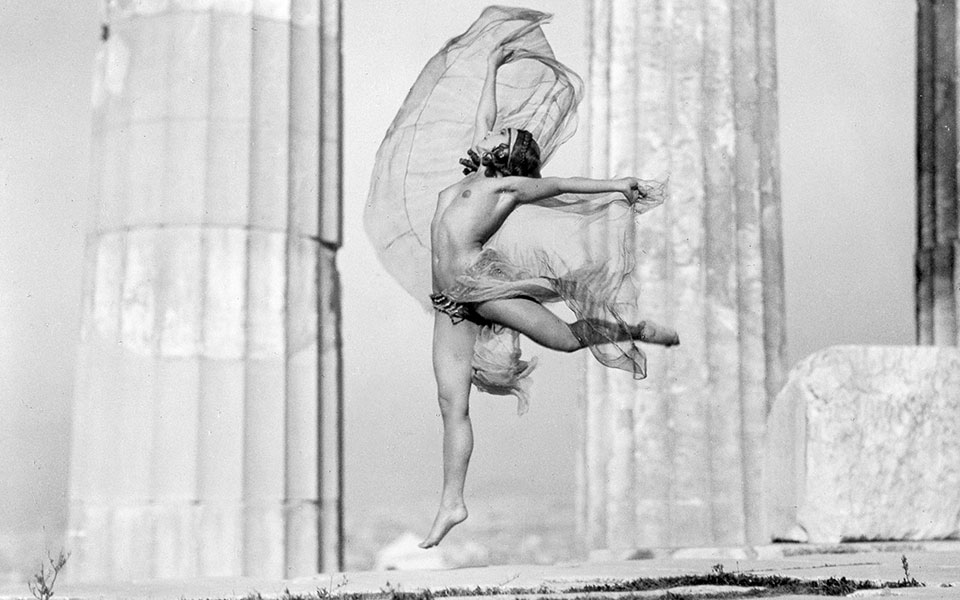Photography
Elli Sougioultzoglou-Seraidari – known as Nelly’s (Aidini, Asia Minor, 1899 – Athens, 1998)
Seraidari’s works remain among the most definitive images of Greece. Her photographs – whether of traditional rural life, urban scenes, or above all of famous monuments – are imbued with a sense of the idyllic. A Greek of the diaspora, she embraced Greece as a spiritual homeland. This vision was also ideally suited to the promotion of Greece abroad, and she was appointed as the official photographer of the Press and Tourism Office.
She was also assigned the decoration of the Greek Pavilion at the 1939 World’s Fair in New York. She was there when WWII began and stayed until 1966, working in advertising photography and with portraiture. Her vast body of work, spanning both decades and themes, serves as a valuable archive, both historically and artistically.
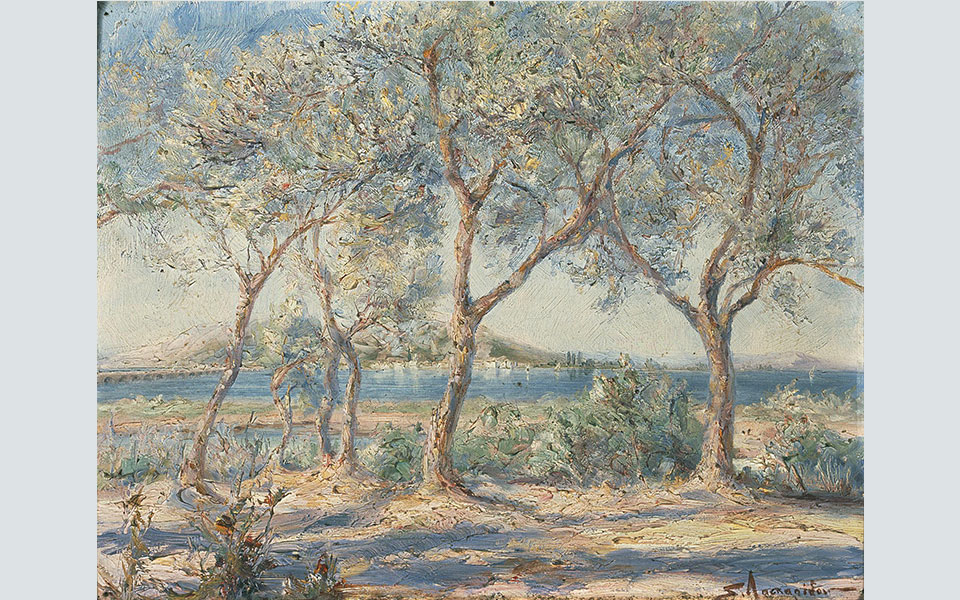
© nationalgallery.gr
Painting and Sculpture
Sofia Laskaridou (Athens 1882 – Athens 1965)
Larskaridou’s magnificent impressionist paintings were radical in their day. Her stylistic boldness was praised by her contemporary, Thalia Flora Karavia, who called her “… an impressionist vanguard with a spontaneous love for color.” Her boldness was not restricted to her canvases; to paint en plein air during a time when the Greek countryside was still rife with bandits led to stories of her venturing out with a gun for protection.
In any event, her skill in capturing the essence of the Greek landscape and light with a strong sense of place garnered her praise from critics and contemporaries, as did her spirit, likened to that of “… a heroic Caryatid, fearless, who crosses meadows and canyons and climbs alone on dry rocks and crags of our picturesque country…; she’s a perfect example of a true artist.”

© nationalgallery.gr
Thalia Flora-Karavia (Siatista 1871– Athens 1960)
Flora, raised in Constantinople, studied in Munich with Nikolaos Gyzis, Giorgos Iakovides, and other prominent figures of the era. In Athens, she had a joint exhibition with Laskaridou, to excellent reception. She later went to Alexandria, where she married the journalist Nikolaos Karavias. She founded a school of art, and was there for three decades.
The Balkan wars brought a definitive period for Flora-Karavia’s career. She accompanied the Greek Army, keeping a diary and producing a wealth of powerful, impressionistic sketches, later published in the book “Impressions of the War of 1912-1913, Macedonia – Epirus.” She also joined Greek troops on the Asia Minor campaign, and then on the Albanian front. These field sketches serve as an artistic and historical record of the terrain, the monuments, and daily lives of the soldiers, and in recognition she was awarded both the Silver Medal of the Athens Academy (1945), and the Cross of the Order of Beneficence (1953). From the war sketches at the War Museum of Athens to the sunny impressionism of “Girl on the Beach” in the National Gallery. Flora-Karavia’s works – both joyous and contemplative – treat their subjects with a notable psychological depth.

© zongolopoulos.gr
Eleni Paschalidou Zongolopoulou (Moda, Istanbul, 1909 – Athens, 1991)
Through her work and life, Paschalidou Zongolopoulou personifies the spirit of the “Generation of the ‘30s” – a term referring to the generation whose creative work was dedicated to interpreting the notion of ‘Greekness’ in the wake of the Asia Minor catastrophe. Leaving Asia Minor for Greece in 1922, her family finally settled in Athens, where she attended the Athens School of Fine Arts, studying drawing with Konstantinos Parthenis. She met the sculptor Giorgos Zongolopoulos (famous for his public works such as the “Umbrellas” of Thessaloniki) after her studies, and they married in 1936.
She embraced the avant-garde in her work – fauvism, cubism, abstraction – and was among the artists representing the country in the Greek Pavilion at the 1939 World’s Fair in New York City. She continued to work actively through 1986. Among her most known works are also public murals, including in the railway station of Corinth, and also in the Medical School of the University of Athens.
One can learn more about her life and work at the George Zongolopoulos Foundation, located at the couple’s former home and studios in Psychiko, Athens.
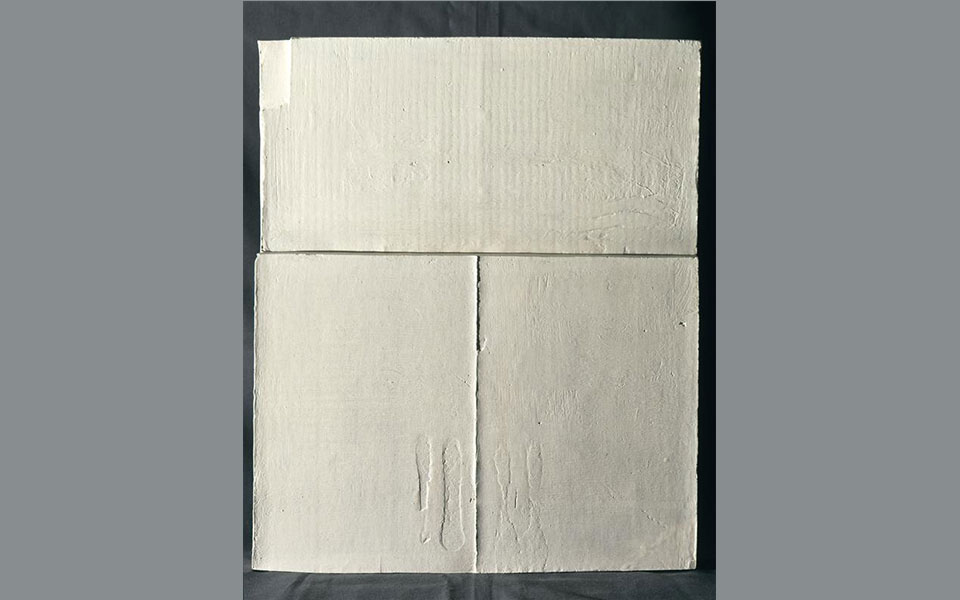
© emst.gr
Chryssa (Athens, 1933 – Athens, 2013)
Chryssa Vardea-Mavromichali, a Greek artist of significant international reputation, went by her mononym. Her 20 Cycladic Books of 1957 – plaster cast in commercial cardboard packing boxes – were praised for their “poetic sharpness,” capturing “the purified and stylized relief characteristic of Cycladic sculpture,” in the words of the French art critic Pierre Restany, and serving as precursors to minimalism in the observation of critic and art historian Barbara Rose.
Chryssa was also a pioneer in the use of neon light. After decades of working in New York City, she left for Athens and converted the abandoned Oasis Cinema, behind the Fix Brewery, into a studio. The Fix Brewery itself has since been converted into the National Museum of Contemporary Art; a Cycladic Book is on display in the permanent collection.
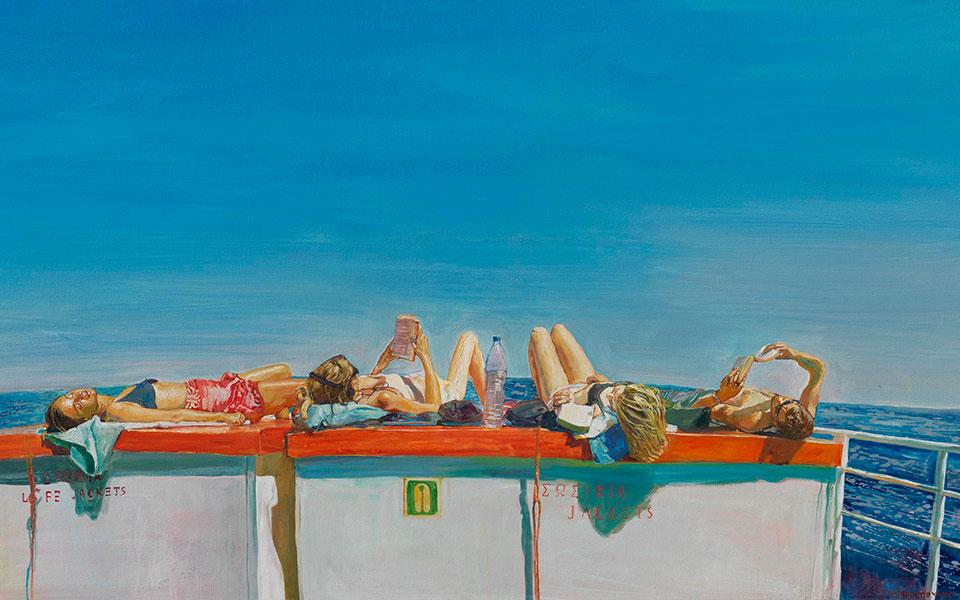
Maria Filopoulou (Athens, 1964)
Filopoulou addresses the most elemental of Greek subjects – water and light – with unique eloquence and depth. After studying at the Ecole des Beaux Arts with Leonardo Cremonini, she moved back to Athens; in an interview with Margarita Pournara, her response to the question about what coming back to Greece was like begins simply with “A return home to light.”
Anyone who has experienced the embrace of the Greek seas under the Mediterranean sun will have an immediate, sensual response to Filopoulou’s paintings. These large-scale works capture the luminescence of the moment, the rays of light refracted by the currents of the sea, playing off of the bodies of bathers submerged in joy. The artist’s own words express the moment best: “My swimmers all experience absolute freedom. Their nakedness emphasizes that sense of freedom and enhances their movements, which are unrestricted, unrestrained and graceful. They have become an element of their watery environment.”
Architecture
Suzana Antonakaki (Athens, 1935 – 2020)
Modernism comes so naturally to Greece. The elemental purity of the Greek landscape, the clarity of the Mediterranean light, and the refined simplicity of the vernacular architecture of the Greek Islands all inspire a modernist sensibility. One of the foremost figures in modern architecture in Greece, Antonakaki founded together with her husband Dimitris Antonakakis and three more of their classmates the architectural office Atelier 66. Both of them had studied at the National Technical University of Athens under Dimitris Pinkionis and Nikos Hadjikyriakos-Ghikas, and were heirs to the Generation of the 30s’ inquiry into Greekness.
Antonakaki and her partner in art and in life shared a great interest in the vernacular architecture of the Greek Islands, embracing in their own works many of the same architectural elements that unite both the structures and the communities that inhabit them: narrow passages and stairways, windows and gateways, courtyards and tiny squares that squares where neighbors gather. These elements found their way into a modernist vision that brings the sense of community of an island village to the urban setting.

© Yiorgos Yerolymbos
Myrto Kiourti (Athens, 1977)
Before leaving for Columbia University to receive her MA in Architecture, followed by a PhD at the National Technical University of Athens, Kiourti practiced architecture at Atelier 66, where she inherited a sensitivity to the uniqueness of the Greek environment. In her work, it’s not the vernacular tradition of Greece but rather Greek society itself that serves as inspiration. The Greekness of Kiourti’s work is felt not in form but in something even more fundamental: the engagement with the family.
The Greek family is a formidable element, the heart of both society and the collective psyche. Extended families often share a building or a compound; integral to Kiourti’s design process are intensive interviews with her clients about their lives – their past, values, dynamics, and dreams. In the Greek social context, Kiourti’s ethereal, honest buildings represent something much more profound that a modernist style upgrade, they’re a reimagining of tradition that honors the strength of the community while letting individualism – the essence of modernism – shine.
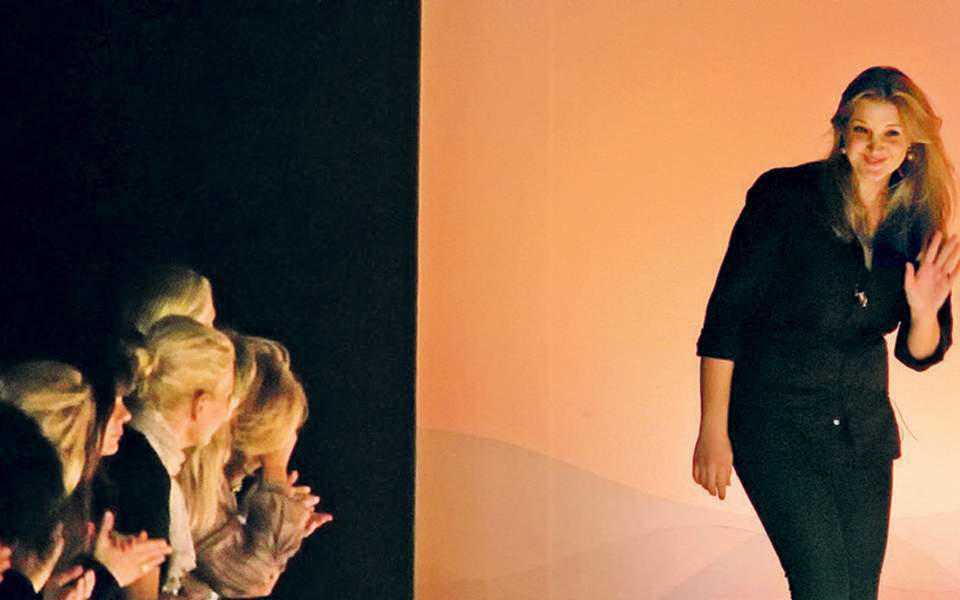
Fashion
Sofia Kokosalaki (Athens, 1972 – London, 2019)
Sophia Kokosalaki had a unique voice, uniting elements of Greece’s sartorial heritage with a contemporary vision. Kokosalaki’s use of drapery and pleating was matchless, showcased in joyful, easy-to-wear dresses that retain an underlying Doric gravity – modern pieces with a rich backstory. “Sophia was the first designer to emerge from Central Saint Martins who fused a European heritage — classical drapery, Hellenic folk craft — with a minimalist sense of how that could be worn on the street or in a club,” wrote Vogue fashion critic Sarah Mower, in her tribute to Kokosalaki.
Anyone who didn’t know this imaginative designer before 2004 certainly did from then on, after she was appointed chief designer of the opening and closing ceremonies of the Olympic Games in Athens. Her work captured millennia of cultural heritage with deep emotion and restrained simplicity. Among the thousands of costumes was the monumental Ocean dress for Bjork; it was a performance in itself.
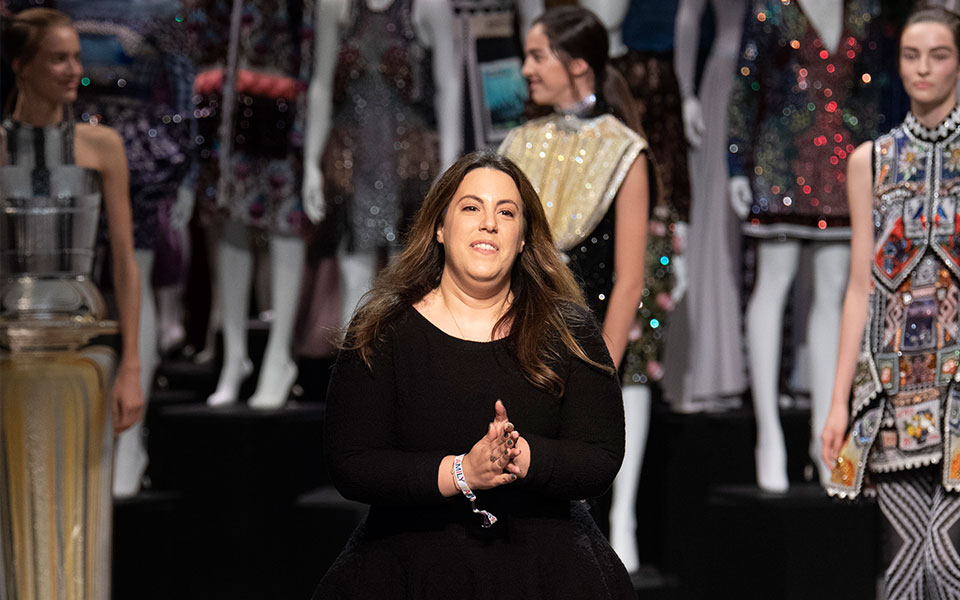
Mary Katrantzou (Athens, 1983)
Katrantzou has redefined the concept of printed fabrics with a bold playfulness that approaches the surreal; Vogue memorably described them on their debut as “almost beyond imaginable limits.” She began her studies, in architecture, at the Rhode Island School of Design, before transferring to Central Saint Martins where she focused on textile design for interiors. While working with Sophia Kokosalaki, her interest shifted to textiles for fashion.
Her debut collection, at the Central Saint Martins M.A. student show of 2008, featured dresses with digital prints of absolutely enormous necklaces. The trompe l’oeil effect was startling, sensational. While Katrantzou sources her inspirations boundlessly – exquisitely cataloged butterflies, the Bauhaus. Her Spring/Summer 2017 collection takes Greece as its inspiration, in designs referencing the Geometric era, Minoan imagery, black figure pottery, and classical motifs with captivating contemporary energy.

